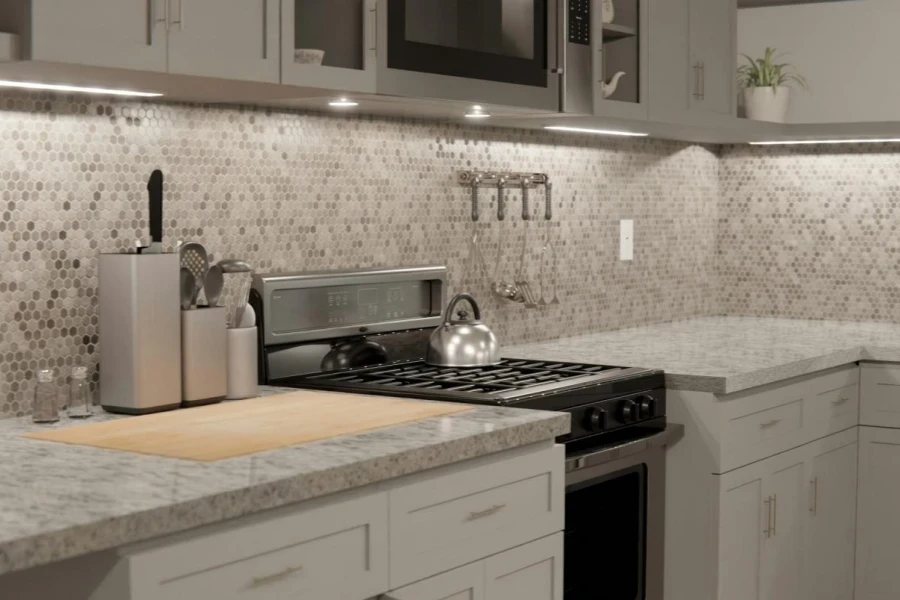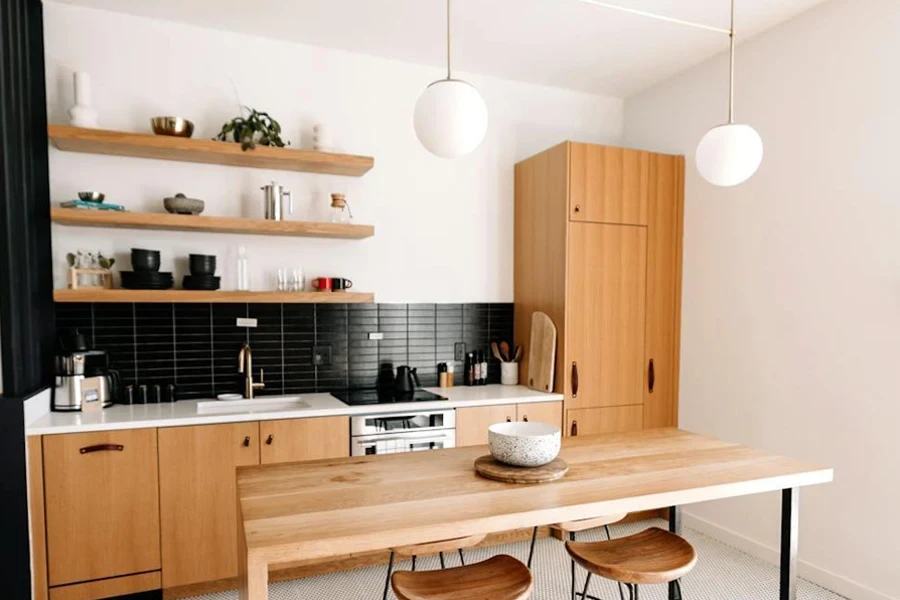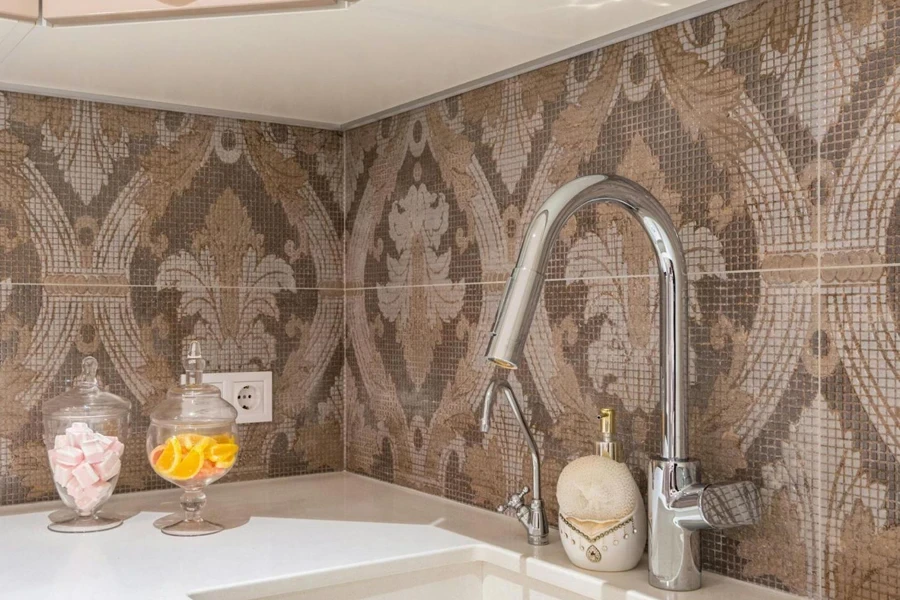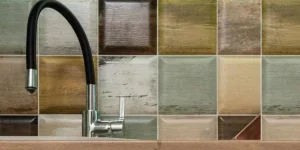Functionality in the kitchen has always been the top priority in every home. Since the Middle Ages, there is evidence of people adopting practical solutions to avoid dirt on the walls adjacent to stoves, fireplaces, and fireplaces.
The first material used was stone, followed by ceramics: in many European castles and monasteries (especially in Italy, France, and Portugal), there are still practically intact beautiful examples of kitchen walls tiled with ceramics of the finest artistry. Ceramics have remained in vogue up to the present day, then joined by porcelain stoneware, which is very resistant and also suitable for flooring, and low-sodium enamel, which makes for great backsplashes that are waterproof and easy to clean.
However, over the last few years, a new innovative solution has been introduced that is taking the market over and comes in panels, sheets, and tiles: the peel-and-stick backsplash. Consumers worldwide are going crazy for it as it significantly reduces installation and maintenance costs, guaranteeing optimal cleaning, sanitization, and design results.
Read on to discover everything you need to to select the best peel-and-stick backsplashes on the market for your buyers in 2025.
Table of Contents
The rise of the peel-and-stick backsplash
Trends and characteristics
Final Thoughts
The rise of the peel-and-stick backsplash

Customers are becoming increasingly attentive to the economic management of resources. They look for interior pieces, furniture, and finishing materials that are practical, cost-effective, and, of course, that still look beautiful.
Peel-and-stick backsplashes are the answer to these needs; they combine the characteristics of easy cleaning and sanitization with a wide choice of materials, shapes, patterns, and colors. They can be applied to existing tiles, wood, metal, masonry, and any other material, allowing combinations with the flooring and furnishing styles of the house.
They come in many different shapes, from panels made of inert and non-toxic materials to sheets of laminated vinyl and even glass with lacquered digital printing. Extremely versatile and available in a vast range of styles, the peel-and-stick backsplash enhances functionality, and it is ideal for those who follow trends and want to change their interior often.
The reasons behind its success
Besides significantly impacting a kitchen’s functionality, the backsplash (sometimes also called “splashback”) impacts the aesthetics of the whole room or area. In addition to protecting the wall and making it easy to clean, the backsplash becomes a customizable decorative element every homeowner can use to personalize their space.
After the Covid-19 pandemic, DIY and Interior Design have become major social media and real-life trends. People want to achieve the professional look they see online in their kitchen and bathroom while also being very mindful of expenses.
These are the reasons behind the growing demand for peel-and-stick backsplash, as it allows just that. Store owners, buyers, and managers should keep an eye on these trends and leverage the increasing demand to drive sales.
Trends and characteristics
When stocking new stick tile backsplashes, retailers should always know what their customers are looking for and what characteristics they value.
Despite peel-and-stick backsplash being a subjective product, some trends and models are likely to sell well, while others should be avoided. Here are some tips:
Mind the format

No matter where your store is or which countries you ship your products to, consumers worldwide tend to choose a format that looks in harmony with their floors and counters when choosing their peel-and-stick backsplash.
Larger adhesive tiles make for a more homogeneous surface with a contemporary and sophisticated effect that looks great with parquet or stoneware floors. On the other hand, a peel-and-stick backsplash with thinner joints and many straight lines lands dynamism to any space while being easier to clean than traditional tiles applied with mortar or grout.
Smaller stick backsplash tiles give more of an informal effect, are great for creating patterns or designs, and have the advantage of adapting better to any niches and irregularities in the wall, making them easier to install.
Also, many insert trendy formats into their inventory, such as subway tiles or hexagonal and diamond stick wall tiles. As for the combinations with the floor, the backsplash can mimic the same material to create continuity and visually expand the space, or it can be in a contrasting color to give character and become the kitchen’s focal point.
Size matters

Peel-and-stick backsplashes often don’t come in tiles but in full panels that can be glued directly onto the wall or previous tiles over the kitchen counter.
One of the biggest trends of the last few years is the floor-to-ceiling backsplash that consumers are trying to recreate in their homes, as well as with adhesive models.
For this reason, these panels should be big enough to cover an entire wall or portion of it without looking disconnected from each other: it can be the color, the finish, the shape, or something else, but they must be in harmonious communication.
Trendy designs

The trends in peel-and-stick backsplashes mirror those for traditional kitchen backsplashes, which include subway tiles, herringbone patterns of different sizes and colors, and natural-stone-look tiles that echo the floor and the counters.
However, some designs are easier to achieve through adhesive tile panels and, therefore, register a spike in sales worldwide. These include:
- Mosaic style:This peel-and-stick backsplash reproduces a tile or a sequence of larger or smaller tiles with different finishes (rough, smooth, opaque, lapped, glossy, with iridescent reflections) and other colors, both monochromatic and multicolored, square, octagonal, rectangular, rhomboidal. They can be uniform or represent patterns and designs, like the Portuguese azulejos.
- Wall effect: This design features a succession of rectangular bricks arranged in rows to mimic a rough brick wall.
- Cement tile effect: It’s the reproduction of artistically handcrafted cement tiles composed of cement, marble dust, and iron oxides for coloring.
- Marble effect. Usually, larger stick tiles that mimic various types of marble, from travertine to white marble, which have always been used in kitchens.
- Wood effect: The latest trend in backsplashes is going for wood imitation, a material that has never been used as a backsplash because it is very porous and not waterproof. Still, it has a very accentuated shabby effect as a panel or adhesive tiles.
Final Thoughts
Peel-and-stick backsplashes have emerged as an ideal solution for homeowners seeking a functional yet stylish kitchen upgrade. Their versatility, affordability, and ease of installation make them the perfect option for anyone looking to give their kitchen an easy makeover.
From timeless designs like subway tiles to trendy wood and marble effects, they provide a contemporary look that aligns with modern design trends. As demand for these innovative products continues to grow, they offer a winning combination of aesthetics and practicality, meeting the needs of today’s cost-conscious yet design-savvy consumers.





 Afrikaans
Afrikaans አማርኛ
አማርኛ العربية
العربية বাংলা
বাংলা Nederlands
Nederlands English
English Français
Français Deutsch
Deutsch हिन्दी
हिन्दी Bahasa Indonesia
Bahasa Indonesia Italiano
Italiano 日本語
日本語 한국어
한국어 Bahasa Melayu
Bahasa Melayu മലയാളം
മലയാളം پښتو
پښتو فارسی
فارسی Polski
Polski Português
Português Русский
Русский Español
Español Kiswahili
Kiswahili ไทย
ไทย Türkçe
Türkçe اردو
اردو Tiếng Việt
Tiếng Việt isiXhosa
isiXhosa Zulu
Zulu